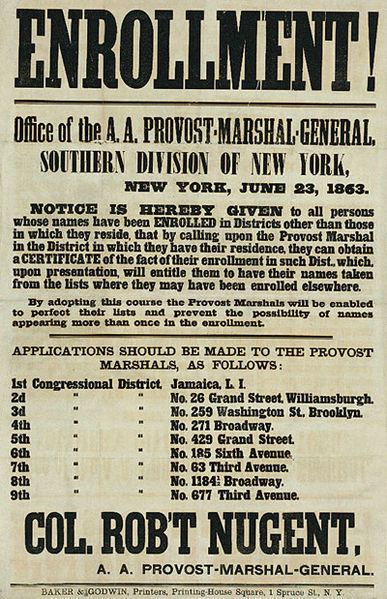Effective March 3, 1863 Start date March 3, 1863 | Statutes at Large 12 Stat. 731 | |
 | ||
Long title An Act for enrolling and calling out the national Forces, and for other Purposes Nicknames Civil War Military Draft Act Location New York City, New York, United States Similar American Civil War, New York City draft riots, Anaconda Plan, Battle of Shiloh, Siege of Vicksburg | ||
The Enrollment Act, 12 Stat. 731, enacted March 3, 1863, also known as the Civil War Military Draft Act, was a legislation passed by the United States Congress during the American Civil War to provide fresh manpower for the Union Army. A form of conscription, the controversial act required the enrollment of every male citizen and those immigrants who had filed for citizenship between ages twenty and forty-five. Federal agents established a quota of new troops due from each congressional district. In some cities, particularly New York City, enforcement of the act sparked civil unrest as the war dragged on, leading to the New York Draft Riots on July 13–16. It replaced the previous Militia Act of 1862.
Contents
Organization
The Provost Marshal General James Barnet Fry administered the national implementation of the Enrollment Act and answered directly to Secretary of War Edwin Stanton. Beneath Provost Marshal General Fry were the State Acting Assistant Provost Marshal Generals. The State Provost Marshal Generals were not authorized by the Enrollment Act, but were appointed personally by James Fry to attend to matters in each individual state. New York and Pennsylvania were the only states that had more than one State Acting Assistant Marshal general; New York had three and Pennsylvania had two. Each state was divided along district lines with each district under the jurisdiction of an enrollment board.
The enrollment boards were headed by a district provost marshal and also included a surgeon and a commissioner. Each enrollment board employed clerks, deputies, and special agents as needed. The enrollment boards divided themselves into sub-districts along ward (in cities) and township (in rural areas) lines. In each sub-district a census was conducted by an enrollment officer to document every man eligible for the draft in the sub-district.
Causes of unrest
The policies of substitution and commutation were controversial practices that allowed drafted citizens to opt out of service by either furnishing a suitable substitute to take the place of the draftee or paying $300. Both provisions were created with the intention of softening the effect of the draft on pacifists, the antidraft movement, and the propertied classes. The result however was general public resentment of both policies. The two practices were major points of contention among the general public and led directly to the slogan "rich man's war, poor man's fight."
Substitution
The policy of substitutions was continued throughout the war. The problem with substitution was that it provided substitutes with powerful incentives to desert soon after enlisting. Career "jumpers" made a living off of enlisting as a substitute, collecting their compensation, deserting before their units were dispatched to the front, and repeating the process. The problem was well known to the military commanders who regularly saw the same recruits repeatedly. In addition, troops furnished by substitution were considered to be of an inferior quality in comparison to regulars and volunteers.
Commutation
Commutation (paying $300 to escape the draft) was created in an effort to keep substitution prices low. If commutation were not instated, the price of a substitute would have quickly soared past $300. Also, commutation was intended to raise money for the war effort. While commutation raised war funds, it was often a criticism of the draft that it was better at raising money than troops. The rationalization for commutation was that unwilling troops were ineffective so the government might as well extract funds from the unwilling if it got poor service. Despite the good intentions behind commutation, it was one of the most hated policies of the war.
1864 amendment
Congress passed an amendment to the Enrollment Act in 1864. Section 5 limited the length of an exemption from the draft by payment of a commutation fee to one year. Then, those drafted were required to serve or to furnish substitutes.
1865 amendment
Congress passed another amendment to the Enrollment Act on March 3, 1865; this is sometimes referred to itself as the Enrollment Act of 1865. Section 21 of the Act (13 Stat. 490) imposed denationalization (loss of citizenship) as a penalty for draft evasion or desertion. Justice John Marshall Harlan II's dissent in Afroyim v. Rusk mentioned the Enrollment Act of 1865 as an example of a law in which citizenship could be revoked without a person's consent and that the Congress then regarded it as constitutional.
